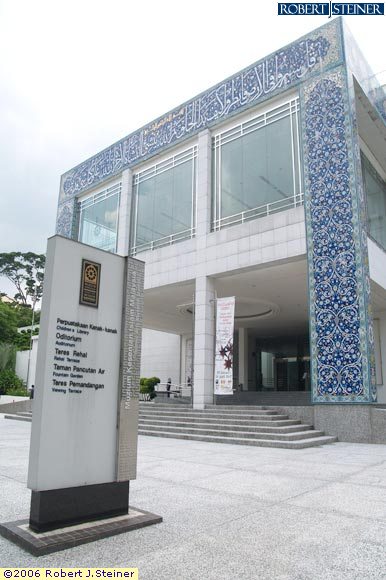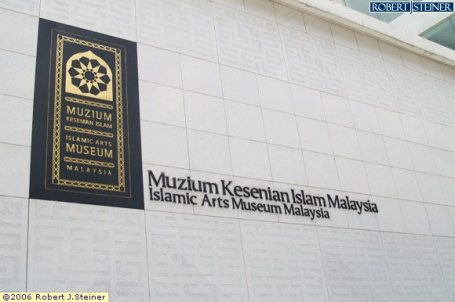Muzium Kesenian Islam
December 3, 2009 at 6:25 am Leave a comment
The Islamic Arts Museum Malaysia building occupies 30, 000 square meters and is located amidst the natural surroundings of Kuala Lumpur Lake Gardens. It caters to the ever-increasing interest in Islamic art; so much so that Malaysia subsequently became home to Southeast Asia’s largest museum of Islamic art in December 1998.
Housing 7,000 over artifacts, the Scholar’s Library is also chocked full with books on Islamic art. In fact, the Library is putting on its finishes touches on preparation. It will eventually become Malaysia’s ultimate study facility for Islamic art. Students and researchers will be allowed to resource from this extensive collection.
The Islamic Arts Museum Malaysia (IAMM) is divided into two floors of galleries, and two other special galleries are built separately for occasional exhibitions. The exhibition areas of the Islamic Arts Museum permit an uninterrupted flow of movement from one site to the other; maintaining the belief of a sense of continuity embodied in the Islamic spirit. The IAMM displays a range of artifacts, from the tiniest items to one of the world’s largest architectural models of the Mecca’s Masjid al-haram. To truly fulfill the aim of the Islamic world collection, works from the heartlands of Persia, the Middle East, China, India and Southeast Asia are honorably displayed at the IAMM. As with India, China and the Malay world, other worldly collections are displayed according to twelve types in the Museum: Jewelry, Arms & Armor, Textiles, Living with Wood, Coins, Metalwork, Ceramics, Architecture, Qur’an & Manuscripts, India, China & the Malay World.
- Many of the world’s finest collections of jewelry come from Islamic lands, and the elites of various Islamic societies generally prefer diamonds, emeralds and rubies, pearls and few other semi-precious stones. Gems encrusted in nose accessories and toe rings are two common types of personal adornment in the Islamic community.
- In the Islamic world, the arms & armor of war are not only beautified; there is also a spiritual dimension to it. Watered steel was perfect in the making of high quality Islamic armor, mainly swords, daggers, axes, maces and spears.
- From ancient till recent times, Islamic textiles are used in align with status, wealth and religious allegiance. The finest textiles define luxury in their own terms. Early Islamic textiles are usually found in fragments, but the IAMM collection comprises of more complete examples, and is mostly derived from the eastern end of Islam.
- Living with Wood showcases admired carving from the Islamic world. Craftsmen lavished love and care on wood, which was very rare in some areas. They combined the different types of wood with other precious materials like ivory and even mother-of-pearl. Islam cultural works bring out two-dimensional beauty in its wood art pieces.
- Up till this day, coins throughout the Islamic world are highly calligraphic, usually with religious inscriptions and imprints of rulers’ details. IAMM contains a wide range of century-old seals; their most common materials being jade, agate, chalcedony and carnelian. Metal was also used extensively in seals and coins, and can sometimes offer detailed history facts when inscribed dates are visible.
- Most of the Islamic metalwork in the IAMM today may have only been made of base alloys, but these were highly important in their own time. Many pieces were even signed by their makers, suggesting the fact that they were objects held in high regard.
- Muslim potters created ceramics that stood out in terms of originality. Influences came mainly from China, but each of the results is still unique to the cultures that it is derived from. The IAMM exhibits range from Nishaphur calligraphic bowls to Kashan lusterwares.
- Architecture was an early defining point in Islamic culture and still retains its importance today. A comprehensive collection of scale models are displayed in the IAMM, ranging from the Mecca’s Masjid al-Haram, to the played-down elegance of the Central Asian mausoleums dedicated to Timur and Amir Albukhari. The gallery re-creates the interior of a mosque to enhance and give a more intimate impression of these sacred spaces.
- The earliest Qur’an & manuscripts are dated all the way from the 8th century. Scribes hailed from the Islamic elite, and even Kings displayed honed skills in calligraphy. Much more than just sacred works, other manuscripts like astronomy, mathematics and medicine also led the world in scholarship.
- Babur, the founder of the Mughal empire from 1526 to 1828, set the stage for the spreading the brilliance of Islamic art throughout India. The most commemorated contribution from the Mughal family was an end product of Central Asian and Indian cultures. For the Mughals, fashion was as much an interest as was jewelry; and their court triumphs were celebrated by their architectural achievements.
The IAMM India Gallery’s features include a beautiful portrait, vessels and other types of tableware.
- Islamic art in China has recently been recognized by art historians, and is now receiving its long-deserving accolade. Calligraphy is a respected art form in China, and is also ideally Islamic for most parts. The most distinctive art displayed are calligraphic scrolls that were scribed by the Chinese.
- In the Malay World, subjects such as plants, fruits and clouds form Southeast Asian Islamic art, and are mostly found as abstract art on textiles. Craftsmanship range from wood and metalwork – especially in the usage to create kris daggers; a renowned Malay traditional showpiece. Another art that deserves more focus is the Qur’anic manuscripts. The IAMM recognizes that need and displays Qur’ans from the Malay East Coast that is well-recognized for its calligraphic expertise.
The IAMM offers to its visitors the Museum Shop, a widely-varied store with offers of books and artifacts from around the world. This is a treasure trove filled with Southeast Asian woodwork for home décor, intricate Middle Eastern jewelry for ladies to adorn, and even books emphasizing on the Islamic world & its art. Children will be occupied by the assortment of books, puzzles and other fun materials while adults take their time to browse around. There is also a smaller outlet one floor below the Museum Shop, dedicated exclusively to souvenirs that are locally produced by the IAMM.
Visit the Islamic Arts Museum Malaysia and its Museum Shop everyday from 10am to 6pm except for Mondays. It is even open on public holidays so that the whole family can enjoy the educational experience! Ticket charges for adults and children are RM12 and RM6 respectively, and cost only RM10 & RM5 if Special Galleries are closed for the day.
Entry filed under: places.



Trackback this post | Subscribe to the comments via RSS Feed